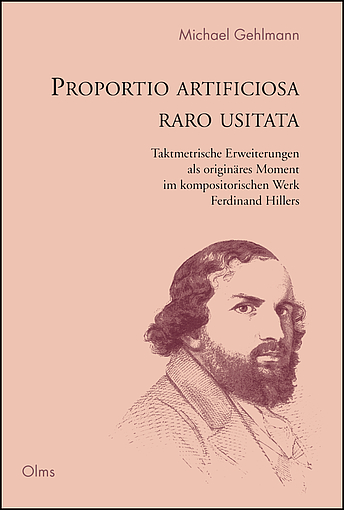Gehlmann
Proportio artificiosa raro usitata
ISBN 978-3-487-15712-2
englisch"Even if Hiller did not invent the principle of combinatory rhythms, he nevertheless developed it to a point where one can evaluate such a procedure more comprehensively and more precisely than in the case of any other composer". Although this polemic of Liszt's addressed to Adolf Bernhard Marx amounted to a Hiller apology that could hardly be consensual in 1855, Liszt's assertion that Hiller's Rhythmische Studien offered "not so little of the new" as Fétis had already supposed, obviously points to a fruitful novelty. It therefore seems plausible to develop the de facto rhythmic question posed by Liszt - despite all differences - from Hiller's compositional work. This book, starting from Wolfgang Caspar Printz's proportio artificiosa raro usitata (1668), first traces the history of the always latently present attempts to overcome the narrowness of a merely dichotomous meter metric, and positions Hiller's rhythmic borderlines of 1851 in the historical context thus gained. From here, a line can be drawn to Liszt's great symphonies all the way to the 5/4 measures in the third act of Tristan. The appendix contains the first comprehensive Hiller catalog raisonné. ((Gek. WT:)) "Even if Hiller did not invent the principle of combinated rhythms, he nevertheless developed it to a point at which one can evaluate such a procedure more comprehensively and precisely than with any other composer." (Franz Liszt) This book, based on Wolfgang Caspar Printz's proportio artificiosa raro usitata (1668), first traces the history of the always latent attempts to overcome the narrowness of a merely dichotomous metrical system, and then positions Hiller's rhythmic border crossings of 1851 in the historical context thus gained. From here, a line can be drawn to Liszt's great symphonies all the way to the 5/4 measures in the third act of Tristan. The appendix contains the first comprehensive Hiller catalog raisonné.
„Wenn auch Hiller das Princip combinirter Rhythmen nicht erfand, so entwickelte er es doch auf einen Punct, auf welchem man ein solches Verfahren umfassender und genauer beurtheilen kann, als bei irgend einem anderen Componisten.“ Obwohl diese an Adolf Bernhard Marx gerichtete Polemik Liszts einer 1855 kaum konsensfähigen Hiller-Apologie gleichkam, weist Liszts Behauptung, Hillers Rhythmische Studien böten „nicht so wenig des Neuen“, als es Fétis schon vermeint habe, offensichtlich auf ein fruchtbares Novum. Es scheint daher plausibel, die de facto von Liszt gestellte rhythmische Frage – aller Differenzen zum Trotz – aus dem kompositorischen Werk Hillers zu entwickeln. Dieses Buch zeichnet im Ausgang der Wolfgang Caspar Printz’schen proportio artificiosa raro usitata (1668) zunächst die Historie der stets latent gegenwärtigen Versuche, die Enge einer nur dichotomen Taktmetrik zu überwinden, und positioniert Hillers rhythmische Grenzgänge von 1851 im so gewonnenen historischen Kontext. Von hier lässt sich eine Linie ziehen zu den großen Sinfonien Liszts bis hin zu den 5/4-Takten im dritten Tristan-Akt. Im Anhang befindet sich das erste umfassende Hiller-Werkverzeichnis. ((Gek. WT:)) „Wenn auch Hiller das Princip combinirter Rhythmen nicht erfand, so entwickelte er es doch auf einen Punct, auf welchem man ein solches Verfahren umfassender und genauer beurtheilen kann, als bei irgend einem anderen Componisten.“ (Franz Liszt) Dieses Buch zeichnet im Ausgang der Wolfgang Caspar Printz’schen proportio artificiosa raro usitata (1668) zunächst die Historie der stets latent gegenwärtigen Versuche, die Enge einer nur dichotomen Taktmetrik zu überwinden, und positioniert Hillers rhythmische Grenzgänge von 1851 im so gewonnenen historischen Kontext. Von hier lässt sich eine Linie ziehen zu den großen Sinfonien Liszts bis hin zu den 5/4-Takten im dritten Tristan-Akt. Im Anhang befindet sich das erste umfassende Hiller-Werkverzeichnis.


